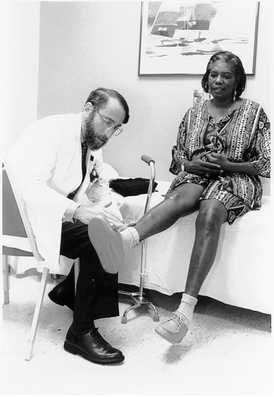
Dr. Howard Kirshner, examining patient Glenda Chatman, is studying whether a new stroke treatment can reduce disabilities caused by the affliction.
New treatment found to ease disabilities resulting from stroke
A new stroke treatment being studied at Vanderbilt University Medical Center is showing significant promise in reducing – and in some cases even eliminating – disabilities resulting from the affliction.
The key to curbing the damage is timing, with the first three hours after the onset of symptoms the most critical. Researchers here and at 50 medical centers across the country are investigating the clot-dissolving drug tPA, which when administered within this three-hour window has been found to lower and even completely halt post-stroke disabilities in over 30 percent of patients.
Dr. Howard S. Kirshner, professor of Neurology, is directing the study along with a newly formed "stroke team," which will be on hand to evaluate arriving stroke patients for participation in the study.
"Acute stroke treatment is very dependent on people knowing about stroke," Kirshner said. "People who develop numbness on one side or are a little bit weak in their arm, or their speech is slurred don't necessarily know to go immediately to the emergency room, which is crucial."
Approximately 500,000 people per year suffer a stroke, making the affliction the leading cause of adult disability in the United States, Kirshner said. Most strokes are ischemic – blood clots that cut off blood flow to the brain.
The clot-dissolving drug tPA is already widely used in the treatment of heart attacks and was recently approved for use in stroke treatment by the Food and Drug Administration. It helps to quickly break up stroke-inducing clots if administered within the first three hours.
"Taking the drug, your chances of coming out of a stroke with a good quality of life are better by 30 percent," Kirshner said. "We know that that's true at zero, one, two and three hours."
A study published in 1995 by the National Institutes of Health established that at least 33 percent of ischemic stroke victims who received tPA in the first three hours after onset of symptoms had minimal or no disability.
In order to be treated with the newly approved drug therapy, a patient must be seen within the first three hours after they experience symptoms of stroke. A CT scan is then performed to determine that the stroke is caused by a blood clot and not a hemorrhage. Head injuries, pregnancy, other recent strokes and a history of heart trouble would also preclude a patient from the tPA study, Kirshner said.
The phase III double-blind, placebo-controlled trial is being conducted to determine if stroke patients can be treated with tPA and still "have a better outcome" than those not treated with the drug, Kirshner said.
Once the trial is under way, patients approved for the study will receive either tPA or a placebo intravenously over a one hour period. They will be evaluated when they first arrive, then reevaluated at two hours, 24 hours, seven days, 30 days and 90 days. Patients will also undergo CT scans at presentation, 24 hours and 30 days, Kirshner said.
Patients participating in the study may not receive any anticoagulants during the first 24 hours after receiving either tPA or the placebo. All other standard medical care will be given while they are in the hospital.
The study seeks men and women between the ages of 18 and 79. Nationally, the goal is to study 800 people in one year. The data from 200 patients in a previous study will also be used, so that the new trial will study a total of 1,000 stroke patients.
The study, being conducted at 50 medical centers across the country, is funded by Genentec Inc.













